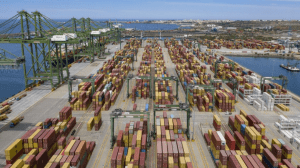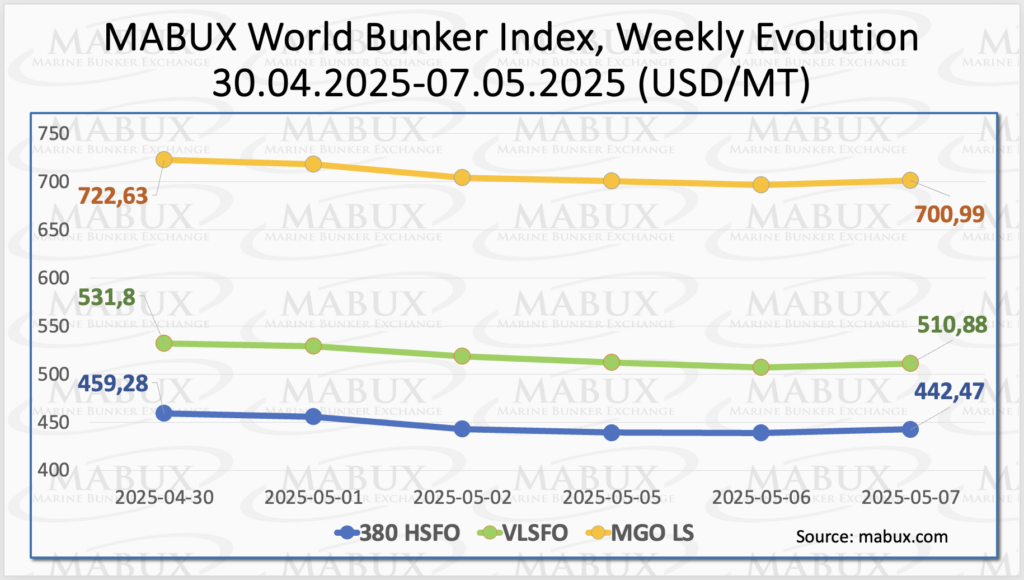Downward trend for global bunker prices

At the end of the 19th week of the year, the Marine Bunker Exchange (MABUX) global bunker indices showed a downward trend.
The 380 HSFO index dropped to US$442.47/M, the VLSFO index declined to US$510.88/MT and the MGO index decreased to US$700.99/MT.
“At the time of writing, the market was showing signs of a moderate upward correction,” noted a MABUX official.

The MABUX Global Scrubber Spread (SS)—the price difference between 380 HSFO and VLSFO—continued its moderate decline, dropping by US$4.11 to US$68.41. The weekly average of the global index also slipped by $0.37.
In Rotterdam, the SS Spread moved in the opposite direction, rising to US$37 in the previous week. The weekly average in the Dutch port saw a marginal increase of US$0.16.
Singapore posted a more pronounced increase in the 380 HSFO/VLSFO differential, up by US$18 to US$78, with the weekly average gaining US$9.67.
“Currently, no significant shifts have been observed in the overall dynamics of the global and port SS Spread indices,” said a MABUX representative, adding: “We expect SS Spread levels to remain stable in the coming week.”

According to a new report from the Institute for Energy Economics and Financial Analysis (IEEFA), the European Union (EU) reduced its combined imports of pipeline gas and liquefied natural gas (LNG) by 18% between 2021 and 2024, in line with a 20% drop in overall gas consumption.
In 2024, Norway emerged as the EU’s largest supplier of pipeline gas, while the United States was the leading supplier of LNG. During the first quarter of 2025, Norway accounted for 30% of the EU’s total gas and LNG supply, followed by the United States with 25%, Russia with 14%, and Algeria with 13%.
As of May 6, European regional gas storage facilities were filled to 41.41%, reflecting an increase of 1.89% compared to the previous week. However, this represents a significant decrease of 29.92% compared to the beginning of the year, when storage levels stood at 71.33%. Despite the seasonal decline, gas reserves in EU storage facilities have resumed a gradual upward trend. At the end of Week 19, the European gas benchmark TTF recorded an increase of 2.89 euros/MWh, rising from 31.856 euros/MWh the previous week to 34.743 euros/MWh.

The price of LNG as a bunker fuel in Portugal’s port of Sines increased by US$13 by the end of the week and reached US$734/MT. At the same time, the difference in the price between LNG and conventional fuel on May 5 was US$77 in favor of conventional fuel against US$42 the week before: MGO LS was quoted on this day in the port of Sines at US$657/MT.

Over Week 19, the MABUX Market Differential Index (MDI)—which reflects the ratio between market bunker prices (MBP) and the MABUX Digital Bunker Benchmark (DBP)—showed the following trends across the 380 HSFO, VLSFO, and MGO LS segments:
- 380 HSFO segment: Rotterdam entered the overvalued zone, joining Singapore. The average weekly MDI values increased by 3 points in Rotterdam and 4 points in Singapore. The remaining two ports were undercharged: Fujairah’s underpricing deepened by 4 points, while Houston saw a 7-point reduction in its undervaluation. Notably, Rotterdam remained at the 100% correlation level between MBP and DBP.
- VLSFO segment: All four monitored ports remained in the undervalued zone. The average weekly MDI values declined by 16 points in Rotterdam, 19 points in Singapore, 15 points in Fujairah, and 23 points in Houston. Singapore is currently approaching a 100% correlation between MBP and DBP.
- MGO LS segment: Rotterdam continued to be the only overvalued port, although its weekly average MDI fell by 5 points. The other ports remained undervalued, with the MDI decreasing by 11 points in Singapore, 15 points in Fujairah, and 23 points in Houston. Rotterdam remains close to full MBP-DBP correlation.

Sergey Ivanov, Director of MABUX, commented: “Overall, no major shifts were observed in the overvaluation/undervaluation structure during the week, apart from Rotterdam’s transition into the overvalued zone in the 380 HSFO segment. Based on current market conditions, we do not anticipate significant changes in the MDI balance next week.”
![]()
The post Downward trend for global bunker prices appeared first on Container News.
Content Original Link:
" target="_blank">


































































